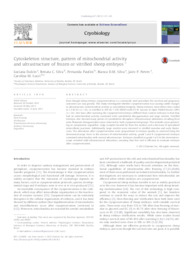Cytoskeleton structure, pattern of mitochondrial activity and ultrastructure of frozen or vitrified sheep embryos.
Cytoskeleton structure, pattern of mitochondrial activity and ultrastructure of frozen or vitrified sheep embryos.
Author(s): DALCIN, L.; SILVA, R. C.; PAULINI, F.; SILVA, B. D. M.; NEVES, J. P.; LUCCI, C. M.
Summary: Even though sheep embryo cryopreservation is a commonly used procedure the survival and pregnancy outcomes can vary greatly. This study investigated whether cryopreservation was causing subtle changes in ultrastructure, mitochondrial activity or cytoskeletal integrity. Sheep embryos were either slow cooled in 1.5 M EG (n = 22), or vitrified in 20% EG + 20% DMSO with 0.5 M sucrose in Open Pulled Straws (OPS) (n = 24). One hour after warming the cryopreserved embryos differed from control embryos in that they had no mitochondrial activity combined with cytoskeletal disorganization and large vesicles. Vitrified embryos also showed many points of cytoskeleton disruption. Ultrastructural alterations resulting from actin filaments disorganization were observed in both cryopreserved groups. This includes areas presenting no cytoplasmic organelles, Golgi complex located far from the nucleus and a decrease of specialized intercellular junctions. Additionally, large vesicles were observed in vitrified morulae and early blastocysts. The alterations after cryopreservation were proportional to embryo quality as assessed using the stereomicroscope. Even in the absence of mitochondrial activity, grade I and II cryopreserved embryos contained mitochondria with normal ultrastructure. Embryos classified as grade I or II in the stereomicroscope revealed mild ultrastructural alterations, meaning that this tool is efficient to evaluate embryos after cryopreservation.
Publication year: 2013
Types of publication: Journal article
Observation
Some of Embrapa's publications are published as ePub files. To read them, use or download one of the following free software options to your computer or mobile device. Android: Google Play Books; IOS: iBooks; Windows and Linux: Calibre.
Access other publications
Access the Agricultural Research Database (BDPA) to consult Embrapa's full library collection and records.
Visit Embrapa Bookstore to purchase books and other publications sold by Embrapa.

